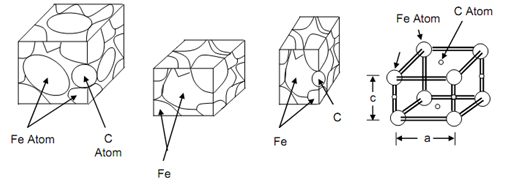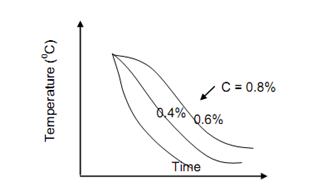Martensite
Carbon atoms cannot move fast through the lattice between temperatures of A3 and A1. The formation of pearlite and ferrite depends upon allowing sufficient time for the movement of carbon atoms. It means that such transformation is possible only under equilibrium condition. It might be realised that the edge of fcc cell is 23% greater than that of bcc cell. If a carbon atom is trapped between two iron atoms, they are kept apart and are not able to take up the position in bcc cell. Carbon atoms in martensite occupy the position on edge of unit cell between two iron atoms and thus elongate the edge and cause distortion. Figure compares austenite, ferrite and martensite unit cells at (a), (b) and (c) respectively. At (d) the size of edge of martensite unit cell on which the carbon atom size is compared with other edge on which there is no carbon atom. As a result a distorted lattice is obtained. It might be emphasised that such distortions resulting into regions of high strain energy, should impede the movement of dislocations whereby the material would lose its ductility or increase its hardness. This trapping of carbon atom among atoms of Fe occurs when the steel is not allowed to cool in equilibrium condition or in other words it is suddenly cooled from A3 to room temperature or to about 300oC. This process of sudden cooling from A3 is called quenching which may be achieved by plunging a heated steel (A3 temperatures) into water or some other quenching medium. Throughout this process the carbon does not have sufficient time to diffuse or carbon does not occur below a temperature 300oC hence a quench treatment in which temperatures is suddenly dropped from A3 to 300oC is sufficient to create permanent hardening in steel. If the resulting structure is checked under microscope it appears to be needle like, often referred to as acicular, and is called martensite.

Figure: Comparison of Unit Cells of Austenite, Ferrite and Martensite Also Dimension are Compared at (d)
Different carbon contents will naturally result in different hardness. At low carbon levels there is very little change in hardness. The noticeable change in hardness is attained when carbon content is at least 0.4% and reaches a maximum at eutectoid composition of 0.8%. The hardness that can be achieved through martensite transformation at 0.4 and 0.8% C are respectively 255 VHN and 530 VHN. Also formation of martensite based upon the cooling rate. As the carbon content raise the critical cooling rate becomes slower. For plain carbon the critical cooling rates steels differ between 400oC/sec & 500oC/sec. This means that it is simpler to harden steel containing 0.8% C than the one containing 0.4% C Quenching in water results in fastest cooling rate and corresponds to critical cooling rate for 0.35% carbon. This is not good for hardening. Figure illustrated the critical cooling curves for some of plain carbon steels.

Figure : Critical Cooling Rate for Different Carbon Content